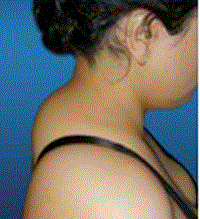What’s that Hump Behind my Neck? Can it go away?
What’s that Hump behind my neck? Can it go away?
One of the things I never anticipated when I decided to become a chiropractor was the number of people I would see whose chief complaint was a cosmetic issue. It’s true that posture can have significant effects on your perceived attractiveness, and even your ability to get the job you’re looking for.
One of the most concerning and common postural deformities for women is seen on the image to the left. The small little hump at the point where the neck meets the upper back. Most women feel like this hump makes them appear heavier and older, and they frequently report using their hair to cover it up. It is a common posture in women as they age, so it naturally creates a sense of insecurity about one’s age when it starts to appear
What is this mysterious hump? Is it a result of aging? Is it a result of weight gain? Is it treatable?
Doweger’s Hump
This rounding of the neck/upperback goes under the name of Doweger’s Hump. It was originally used to describe the rounding seen in older women who have had compression fractures in their spine, and the deformed vertebrae causes the spine to compensate into a humping appearance. This is the classic sense of Doweger’s humping.
Today, this term is used to describe a pronounced rounding of the spine near the head and neck. Not all rounding is bad. In fact, the upper back is supposed to have a slight rounded appearance called a kyphosis. In the more pronounced cases, it’s called a “hyper” kyphosis, which basically just means, extra curving. This rounding is often accompanied by a small pad of fat or fibrous tissue on the tip of the hump.
This rounding can be caused by postural distortion and muscular imbalances affecting the neck, chest, and upper back.
What Causes That?
If the humping is not related to spinal fracutres and osteoporosis, then you are dealing with a problem that is primarily posture related.
Common causes of poor posture include:
1. Sitting at a computer 5+ hours/day
2. Chronic use of mobile devices (text neck)
3. Muscular imbalances usually occupational related
4. Conditions like Parkinson’s disease, Marfan’s Syndrome.
5. Structural Shifts of the spine (Atlas Displacement Complex and Anterior Head Syndrome)
Can it be Reversed?
Remember that a humping related to a deformity in the spine like a fracture, severe scoliosis, or congenital malformation is not changeable. You cannot change the shape of anatomy that has been broken or misshapen.
However, if the humping is related to posture, then there are options for it’s improvement.
– Postural corrective exercises can be performed to strengthen the posterior chain.
– Massage therapy can be performed to address the muscular dysfunction of upper cross syndrome
– Fat pad removal is becoming a more popular technique performed by plastic surgeons to remove the squishy pad feeling on the back of a hump.
These steps can help reduce the cosmetic effects of Doweger’s.
However, there is a real Structural problem stemming from this phenomenon. The reason most people who have this humping are older is because a shifting of the spine can advance the age of your spine through degeneration.
One of the most important conditions to address in people with Dowager’s hump is Anterior Head Syndrome.
When the head shifts forward, it causes the shoulders and thoracic spine to round. When left there over time, the facet joints of the neck stop moving smoothly and lock the head in that forward position. When this head forward movement is corrected, the rest of the spine will often shift back into a normal position again and reduce the rounding on its own.
Reducing Anterior head syndrome can reduce the appearance of Dowager’s, but it’s effects go far beyond that. If you’re serious about correcting Doweger’s, then don’t let your fix be purely cosmetic in nature.






Leave a Reply
Want to join the discussion?Feel free to contribute!